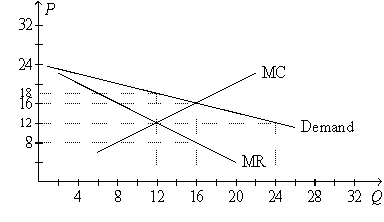A) oligopoly.
B) monopoly.
C) monopolistic competition.
D) perfect competition.
Correct Answer

verified
Correct Answer
verified
Multiple Choice
For a profit-maximizing monopolistically competitive firm,marginal revenue exceeds marginal cost in
A) the short run but not in the long run.
B) the long run but not in the short run.
C) both the short run and the long run.
D) neither the short run nor the long run.
Correct Answer

verified
Correct Answer
verified
Multiple Choice
Each firm in a monopolistically competitive industry faces a downward-sloping demand curve because
A) there are many other sellers in the market.
B) there are very few other sellers in the market.
C) the firm's product is different from those offered by other firms in the market.
D) the firm faces the threat of entry into the market by new firms.
Correct Answer

verified
Correct Answer
verified
Multiple Choice
A monopolistically competitive firm chooses its
A) price and quantity just as a monopoly does.
B) quantity but faces a horizontal demand curve just as a competitive firm does.
C) price but can sell any quantity at the market price just as an oligopoly does.
D) price and quantity based on the decisions of the other firms in the industry just as an oligopoly does.
Correct Answer

verified
Correct Answer
verified
Multiple Choice
Long-run profit earned by a monopolistically competitive firm is driven to the competitive level due to a(n)
A) change in the technology that the firm utilizes.
B) shift of its demand curve.
C) shift of its supply curve.
D) increase in the firm's average cost of production.
Correct Answer

verified
Correct Answer
verified
True/False
For a profit-maximizing firm in a monopolistically competitive market,when price is equal to average total cost,price must lie above marginal cost.
Correct Answer

verified
Correct Answer
verified
Multiple Choice
Which of the following is not an argument made by critics of advertising?
A) Advertising manipulates people's tastes.
B) Advertising impedes competition.
C) Advertising promotes economies of scale.
D) Advertising increases the perception of product differentiation.
Correct Answer

verified
Correct Answer
verified
Multiple Choice
Table 16-2
The following table shows the total output produced by the top six firms as well as the total industry output for each industry.
 -Refer to Table 16-2.What is the concentration ratio for Industry B?
-Refer to Table 16-2.What is the concentration ratio for Industry B?
A) about 12%
B) about 32%
C) about 39%
D) about 51%
Correct Answer

verified
Correct Answer
verified
Multiple Choice
Table 16-6
Traci's Hairstyling is one salon among many in the market for hairstyling. The following table presents cost and revenue data for haircuts at Traci's Hairstyling.
 -Refer to Table 16-6.What is the profit-maximizing output for Traci's Hairstyling?
-Refer to Table 16-6.What is the profit-maximizing output for Traci's Hairstyling?
A) 3 haircuts
B) 4 haircuts
C) 5 haircuts
D) 6 haircuts
Correct Answer

verified
Correct Answer
verified
Multiple Choice
Table 16-7
A monopolistically competitive firm faces the following demand schedule for its product. In addition, the firm has total fixed costs equal to $10.
 -Refer to Table 16-7.If the firm has a constant marginal cost of $5 per unit,how many units should the firm produce to maximize profit?
-Refer to Table 16-7.If the firm has a constant marginal cost of $5 per unit,how many units should the firm produce to maximize profit?
A) 3 units
B) 4 units
C) 5 units
D) 6 units
Correct Answer

verified
Correct Answer
verified
True/False
Critics of advertising argue that advertising leads to less elastic demand for products and a larger markup of price over marginal cost.
Correct Answer

verified
Correct Answer
verified
Multiple Choice
Table 16-3
The following table shows the output produced by each of the top eight firms in four industries as well as the total industry output for those industries.
 -Refer to Table 16-3.Based on the concentration ratio,which industry is the most competitive?
-Refer to Table 16-3.Based on the concentration ratio,which industry is the most competitive?
A) Industry A
B) Industry B
C) Industry C
D) Industry D
Correct Answer

verified
Correct Answer
verified
Multiple Choice
Which of the following statements is correct?
A) The more similar Firm A's product is to Firm B's product, the more likely Firm A is to advertise.
B) Monopolistically competitive firms advertise in order to increase the elasticity of the demand curve they face.
C) According to the signaling theory, the more product information an advertisement contains, the more effective it is.
D) Brand names may help consumers if they provide information about the quality of a product when acquiring such information is difficult.
Correct Answer

verified
Correct Answer
verified
Multiple Choice
Regulation of a firm in a monopolistically competitive market
A) usually implies a very small administrative burden.
B) will lower the firm's costs.
C) is commonly used to enhance market efficiency.
D) is unlikely to improve market efficiency.
Correct Answer

verified
Correct Answer
verified
Multiple Choice
Table 16-1
The following table shows the percentage of output supplied by the top eight firms in four different industries.
 -Refer to Table 16-1.Which industry has the highest concentration ratio?
-Refer to Table 16-1.Which industry has the highest concentration ratio?
A) Industry W
B) Industry X
C) Industry Y
D) Industry Z
Correct Answer

verified
Correct Answer
verified
Multiple Choice
A concentration ratio
A) measures the percentage of total sales of the top firm in the industry.
B) reflects the level of competition in an industry.
C) is inversely related to the price charged by the top firm in the industry.
D) All of the above are correct.
Correct Answer

verified
Correct Answer
verified
True/False
When a monopolistically competitive firm is in a long-run equilibrium,the values of marginal cost,average total cost,and price are all the same.
Correct Answer

verified
Correct Answer
verified
True/False
The "monopoly" in monopolistically competitive markets is most likely a result of firms having some pricing power due to product differentiation.
Correct Answer

verified
Correct Answer
verified
Multiple Choice
Figure 16-1. The figure is drawn for a monopolistically competitive firm.
 -Refer to Figure 16-1.The firm's profit-maximizing level of output is
-Refer to Figure 16-1.The firm's profit-maximizing level of output is
A) 8 units.
B) 12 units.
C) 16 units.
D) 24 units.
Correct Answer

verified
Correct Answer
verified
Multiple Choice
When firms in a monopolistically competitive market engage in price-related advertising,defenders of advertising argue that
A) the quality of products sold in the market always increases.
B) customers are less likely to be informed about other characteristics of the product.
C) new firms are discouraged from entering the market.
D) each firm has less market power.
Correct Answer

verified
Correct Answer
verified
Showing 461 - 480 of 497
Related Exams